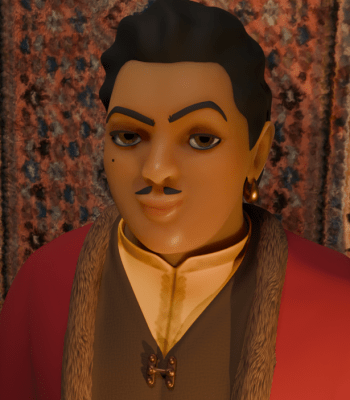What does religious art look like? I'm guessing there is an emphasis on music as an art form closely tied to the Azadi faith? What about visual art, folk arts, etc?
Music, and especially chants and melodies derived from the verses of the Song, are central to the artistic ornamentation of the Azadi faith. But Azadi do consider it important to have beautiful things to look upon when contemplating the wonder of the Dream and its Dreamer. A sirdab is considered the greatest work of religious art in Azadi, incorporating the natural wonders of Annur's creation organized according to principles of aesthetics and reason, Annur's gifts to humankind.
Beyond that, the most prevalent religious art is calligraphy written in a stylized version of the Sirdabi script. Calligraphy has been elevated to a high art form that is incorporated into a vast array of arts and crafts, from architectural design to dishware, and it is used in both formal religious and folk art. Music also has a written form, which can likewise be used as a visual motif. Verses from the Song of God, as well as familiar music to which some of the verses are traditionally set, can both appear in various kinds of art.
There are all kinds of other visual and folk arts across the caliphate. Irzal has a very rich artistic tradition that includes painting and illumination as well as weaving, silversmithing, and more. Zalawi is famed for its pottery which is both beautiful and durable. Ifru produces sculpture, although attitudes towards this are mixed in the caliphate at large (see below). There would be tons of culture-specific variety so people are welcome to come up with their own theme-appropriate ideas here!
Are there Azadi prohibitons against "idolatry", or against visually representing Annur?
Nothing is said in the Perfected Song of God to sweepingly condemn all figural imagery, but there are strong warnings against the idolatry of images and against the hubris of any mortal attempting to portray the divine. There is also long debate about whether creating images of living beings should be construed an attempt to usurp the authority of God, who is the true creator of all things and the dreamer of all images. Due to the general uneasiness around this matter, and perhaps due also to artistic customs predating Azadi, most art in the caliphate is non-figural, and artwork featuring patterns -- of geometric and vegetal forms, stylized calligraphy, and representations of written music, among other motifs -- predominate.
The prohibition against figural imagery is observed the most strongly in the Sirdabi heartland of Rahoum and Marzum. It is less well observed at the fringes of the caliphate, and where older artistic traditions have retained their hold; places like upper Irzal, upper Amunat, and Ifru. Omrazir, with its cosmopolitan atmosphere and extremely diverse population, would be somewhere in the middle. Even in places where attitudes towards figural art are more lenient, it would still be considered the next thing to heretical to portray Annur in any figural way, and though it is not actually prohibited to portray the Prophet Azad, actually doing so is extremely uncommon except in certain Idiri traditions that tend to conflate al-Azad with the heroic demigod Nthanda. In Irzali artistic tradition, Annur may be represented in art by a patch of light or a burst of radiance painted into the picture, much as the God of Good Thought has typically been represented as a flame suspended in midair.
Azadi do tend to look down on the Kalentoi for their great love of religious icons, which is seen as being the next thing to idolatry and just one more indication of how badly Kalentians have lost their way in worshiping the One True God.
Are people afraid of depicting beings considered "evil" or mischievous, lest they draw the attention of such beings?
Most ordinary people are more afraid of naming these beings, as their attention is said to be drawn by the sound of their name. Visually representing evil or mischievous beings is sometimes considered asking for trouble as well, but there is an alternative tradition that accurately capturing the image of such a being can allow some form of control over it akin to knowing its true name.
Are there forms of art or folk art (charms, etc) that are employed for protection (or to attempt to lure hostile intervention toward someone else)?
Protective amulets in the shape of a key are commonly used, which may be inscribed with "O Annur Dreamer of the Dream" to put one firmly under the protection of the One God. Even in the Sirdabi Caliphate's literate society writing is still accorded great symbolic and spiritual power, and other charms consist simply of appropriate verses from the Perfected Song written out on a piece of paper or papyrus, which is kept about one's person. Papyrus is particularly suited for the instillment of magical energy, so this is the preferred material for a potent charm. Poorer folk, however, are content to rely on paper, inscribed clay, or a stone on which appropriate words are inked.
Talismans in the shape of a closed eye are another very common form of protection, and one which long predates Azadi. Curses against people often include a piece of material on which an open eye has been drawn, looking off to the side. This symbol can also be scratched in the dirt as part of a ritual, or scrawled on a wall or door of the house belonging to the target. The latter can either be done discreetly, so that the victim will be unaware of the curse, or very obviously so as to strike fear into their heart and illuminate their misfortune for all to see.



